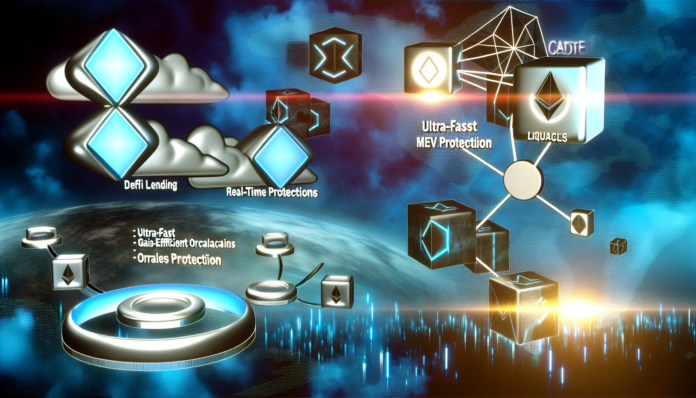Decentralized finance (DeFi) protocols are evolving rapidly to address critical challenges like efficient liquidation processes and protection against market exploits such as Miner Extractable Value (MEV). RedStone, a next-generation blockchain oracle, is pioneering innovations that bring real-time liquidations and native MEV capture to lending protocols using its Atom technology. This development offers major enhancements in speed, accuracy, and security, effectively tightening risk management within lending ecosystems and increasing capital efficiency for users.
RedStone’s Role in Enhancing DeFi Lending Protocols
At the core of many DeFi applications, especially lending protocols, lies the need for reliable and timely price data. Liquidations are triggered when loan collateral falls below a certain threshold relative to the borrowed amount, a process highly sensitive to price fluctuations. Conventional oracles often struggle with latency and high gas costs, which introduce risks of stale or manipulated data. RedStone addresses these issues by delivering low-latency, gas-optimized price feeds across over 50 blockchains, with special focus on yield-bearing collateral types like liquid staking tokens — assets gaining prominence in the DeFi lending space.
The RedStone oracle architecture utilizes modular data retrieval models, including pull, push, and a hybrid of both, tailoring data delivery to the needs of decentralized applications. This modularity allows lending protocols to access real-time price updates with minimal blockchain overhead, crucial for prompt liquidation decisions and minimizing capital risk during volatile market conditions.
Enabling Real-Time Liquidations
Liquidation efficiency is paramount in DeFi due to the volatile nature of crypto-assets that serve as collateral. If under-collateralized positions are not liquidated swiftly, protocols face solvency risks, cascading defaults, and market instability. RedStone’s real-time data streaming supports continuous monitoring of loan-to-value (LTV) ratios, enabling proximate, automated liquidations before critical thresholds are breached.
Traditional liquidation mechanisms suffer from delays caused by infrequent price updates or excessively high gas costs when pushing frequent updates on-chain. RedStone’s push model solves this by continuously updating price data directly on-chain, while its hybrid model allows data pulling only when requested, optimizing costs. This ensures that liquidators and protocols have access to the freshest price data needed to validate under-collateralization events accurately and execute liquidations swiftly and reliably.
Native MEV Capture for Fairer and More Efficient Markets
Miner Extractable Value (MEV) refers to the profit miners or validators can capture by reordering, including, or excluding transactions within a block. In lending and liquidation scenarios, MEV exploitation can lead to unfair front-running, price manipulation, and degraded user experience. RedStone’s Atom technology integrates a native MEV capture mechanism directly into the oracle layer, employing game-theory-driven trust systems and cryptographic proofs to defend against MEV abuses.
This approach not only bolsters the fairness and transparency of liquidation processes but incentivizes validators and liquidators to participate honestly within the ecosystem. By embedding MEV resistance within the data layer itself, RedStone enables lending protocols to safeguard their users from exploitative trading behaviors that have historically undermined DeFi efficiency and user trust.
Advanced Security and Validation Through Actively Validated Service (AVS)
Security is a paramount concern in handling price feeds, as manipulation or inaccuracies can lead to false liquidations or losses. RedStone’s Actively Validated Service (AVS), built using EigenLayer’s restaking protocols, harnesses a decentralized network of professional, community, and supervisory nodes to validate and verify data before publishing it on-chain.
This multi-tiered validation framework ensures feed authenticity by dynamically staking reputation and leveraging academic audits alongside market-making entities as validators. AVS substantially raises the bar for trustworthiness while maintaining cost-efficiency and scalability, helping lending protocols reduce risks related to erroneous or manipulated oracle data.
Modular Architecture for Scalability and Flexibility
RedStone’s oracle system is uniquely designed with scalability in mind, able to serve multiple blockchain environments simultaneously — from Ethereum-compatible networks like Polygon and Avalanche to Layer 2 rollups and non-EVM chains. This level of flexibility is critical given the increasingly fragmented DeFi landscape, enabling protocols to adopt RedStone’s real-time liquidation and MEV capture solutions without compromising cross-chain operability.
Developers can integrate RedStone seamlessly through well-documented APIs and infrastructure designed for low gas usage and high throughput. This reduces barriers to adoption and accelerates the modernization of liquidation protocols while meeting demand for secure, fast, and cost-effective price oracles across diverse DeFi markets.
Impacts on DeFi Lending and Risk Management
By bringing together real-time liquidations and MEV-resistant data feeds, RedStone redefines how DeFi lending protocols manage risk and protect value. The immediate availability of accurate price data empowers liquidation bots to act precisely and promptly, preventing systemic instability triggered by price slippage or flash crashes.
Furthermore, the native MEV capture mechanism creates a more level playing field, decreasing predatory behaviors that can exacerbate market volatility and user losses. This tighter integration between oracle technology and liquidation processes enhances protocol sustainability, user confidence, and overall ecosystem health.
Looking Ahead: The Future of Liquidations Powered by RedStone
As the DeFi sector continues to grow, the demand for more sophisticated, resilient, and fair liquidation mechanisms will only increase. RedStone’s innovations position it as a critical infrastructure layer that enables lending protocols to scale safely while adapting to evolving market conditions. The real-time, MEV-resistant oracle infrastructure ensures protocols remain solvent, borrowers are treated fairly, and lenders recover assets effectively.
Going forward, RedStone aims to expand its reach across even more blockchain networks and asset classes, further broadening access to next-level oracle services that drive real-time, secure financial primitives on decentralized platforms.
Conclusion
RedStone’s integration of real-time liquidation capabilities with native MEV protection marks a significant leap in DeFi infrastructure. By delivering ultra-low latency, cost-efficient, and highly secure price feeds, RedStone empowers lending protocols to reduce risk, improve liquidation accuracy, and provide a more trustworthy environment for all participants. This convergence of oracle innovation and liquidation mechanics fosters deeper resilience and trust within the decentralized finance space, paving the way for safer, more scalable lending ecosystems worldwide.
















